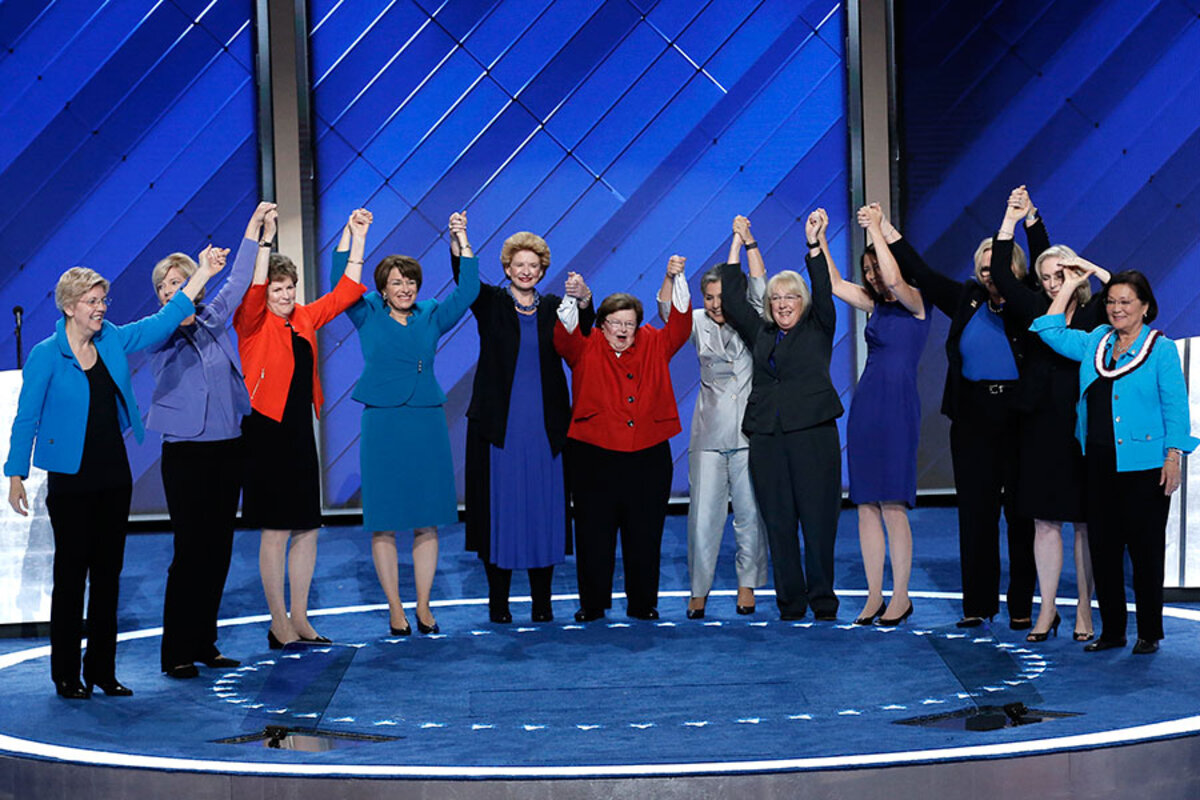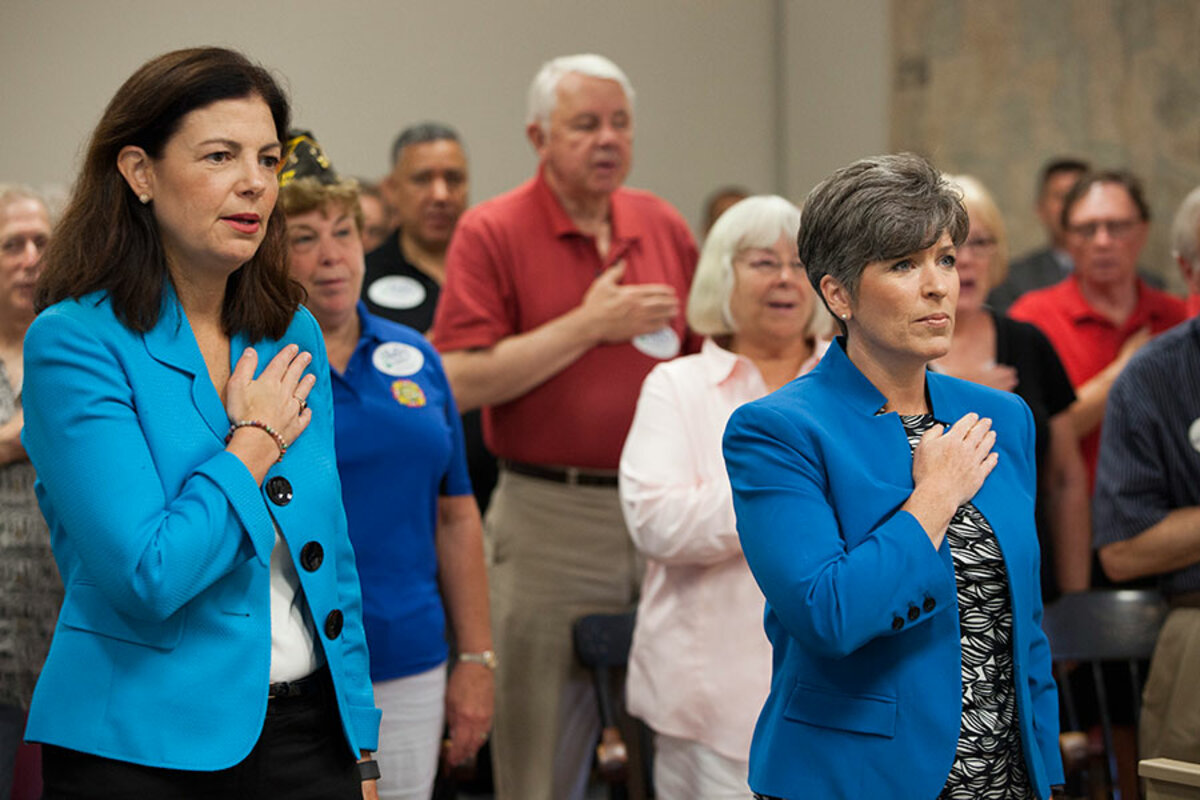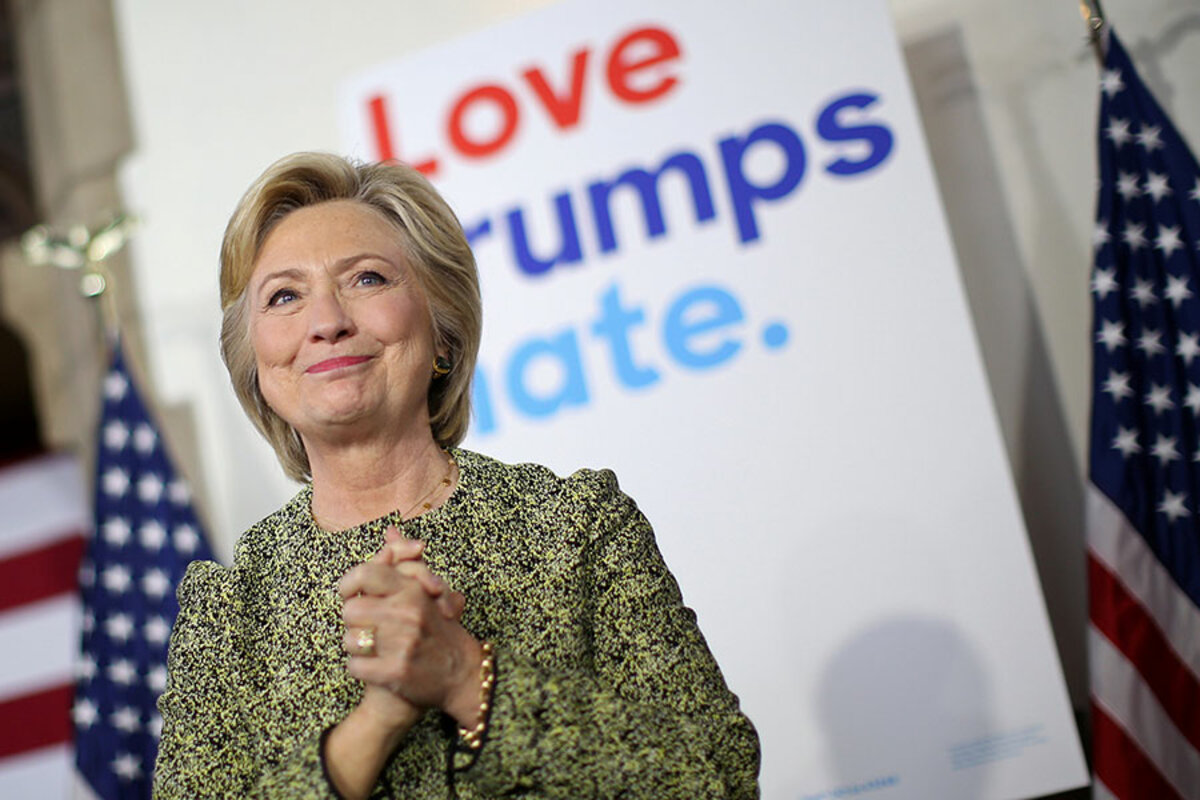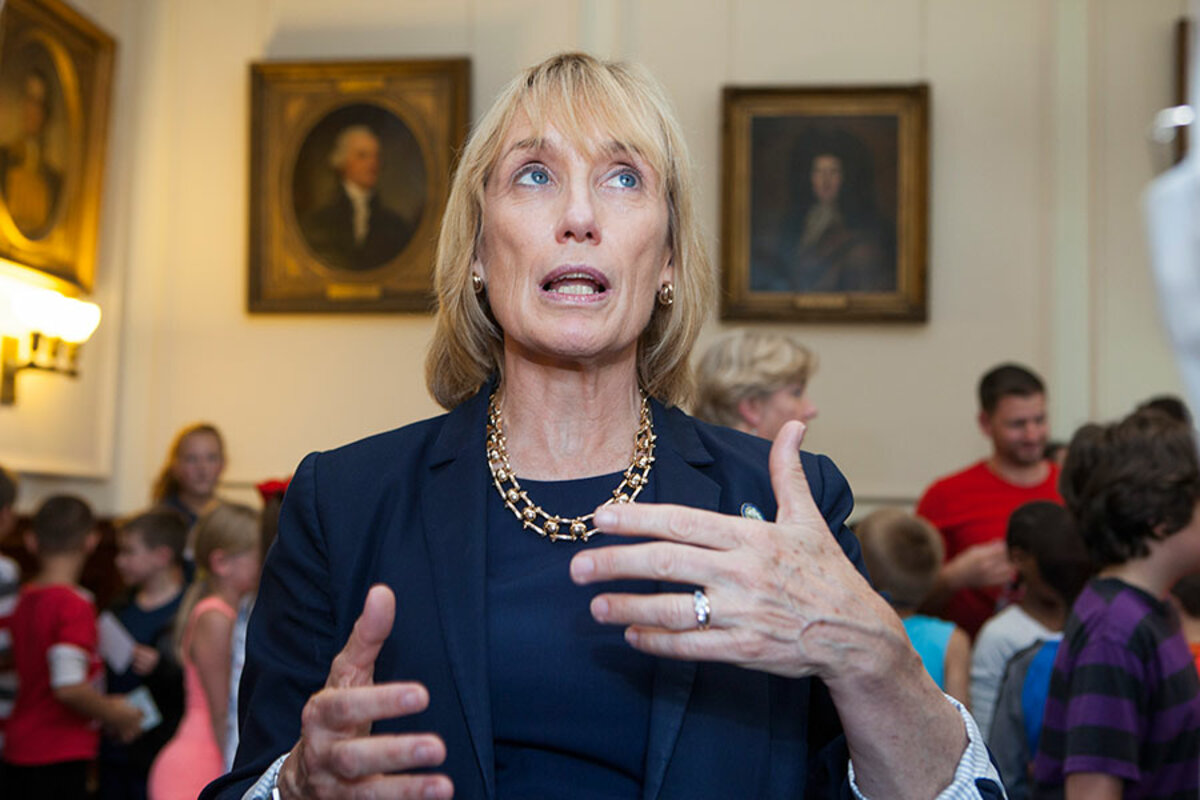How women lead differently
Loading...
| Amherst, N.H.
Kelly Ayotte and Joni Ernst take the floor, two dynamic young US senators before a town hall of older military veterans. Between them, they represent a raft of firsts: Senator Ayotte is New Hampshire’s first female attorney general and first female Republican senator. Senator Ernst is Iowa’s first woman ever elected to either house of Congress and the first female military veteran to serve in the Senate.
The gender dimension does not go unnoticed. Please welcome “our beautiful senators,” says the veteran who introduces them. Ayotte mentions Ernst’s military service – she’s also a war veteran. But in most ways, the woman thing doesn’t matter. This is just like any other political town hall in campaign season – one senator trying to help another who’s locked in a tight reelection race.��
Yet the stakes are high. Republican control of the US Senate could hinge on Ayotte’s ability to fend off her Democratic challenger, Gov. Maggie Hassan. And across the country, women figure prominently in the Democrats’ strategy to retake the Senate, nominating women in six of the 11 competitive races.��
Then there’s Hillary Clinton, the first woman to win a major party’s presidential nomination in the United States.��
It’s enough to call 2016 Year of the Woman 2.0, following the original, 1992, when female representation in the Senate jumped from two to six. Today, female senators number 20 out of 100, with potential to reach 24, depending on how the political winds are blowing by Election Day.��
Gender diversity among major world powers is also rising, with the ascension of Theresa May to the British prime ministership. If Mrs. Clinton wins in November, three of the world’s top five economies will be headed by women. (German Chancellor Angela Merkel is the other.)
But the numbers and the “firsts” invite a deeper question: Do women really lead differently? From the halls of government to corporate boardrooms, it’s a burning question.��
“I think we’re good listeners, and I think that helps,” says Ayotte in an interview. “I don’t want to say my male colleagues aren’t, because plenty of them are. But I think that we listen, and so we’re picking up on where we see the common ground with other people.”
On that point, there is bipartisan agreement.��
“There is good research that shows women tend to have different leadership styles,” Democratic Sen. Jeanne Shaheen, New Hampshire’s other senator, says in an interview. “We tend to be more inclusive, we’re less autocratic in our decisionmaking. We like consensus, we like to get people around the table, and so I think that has made a difference.”
Of course, there’s also the example of Rep. Nancy Pelosi (D) of California, the first woman speaker of the House (2007-11). During her tenure, she was known for her ability to wield power – and in a highly partisan way. More than with previous speakers, major legislation came out of her office, not the committees. She was (and is) a master fundraiser for Democrats writ large, a skill she has used to great effect in keeping her members in line.��
And as a Roman Catholic woman, Congresswoman Pelosi demonstrated at a crucial moment the power of networking. In 2010, when House passage of the Affordable Care Act appeared in doubt over the abortion issue, she tapped connections her male colleagues had never heard of – two associations of nuns, whose support for the bill proved pivotal.��
The research on women’s leadership style has been extensive – and mixed. One academic study, released in 2013, found that women are more attracted to cooperation than men. The reason is that men tend to have greater confidence in their abilities, while women tend to be more optimistic about their prospective teammates’ abilities,
New research, released in August, looked specifically at gender differences in the US House of Representatives and found “little evidence to suggest women are inherently more cooperative or bipartisan.” The only difference came with Republican women, who tend to recruit more cosponsors on legislation, including more from the opposite party. That tendency was most pronounced on so-called women’s issues, such as education and social welfare.��
“We interpret these results as evidence that cooperation is mostly driven by a commonality of interest, rather than gender per se,”
The study examined 20 years of data ending in 2008. Since then, female representation in Congress has ticked up a notch, reaching 20 percent in the Senate and nearly that in the House – the rough threshold for a perceived “critical mass” of representation in which women can show perceptible influence.��
Indeed, since 2013, female legislators point to multiple examples of how the women of the Senate, in particular, have been instrumental in breaking through congressional gridlock. is the end of the 2013 government shutdown, when women senators from both parties met privately over dinner and fashioned a compromise that would form the nucleus of the final deal.��
More recently, the women of the Senate – all 20 of them, dubbed “the sisterhood” – backed landmark legislation aimed at combating sex trafficking, which President Obama signed into law in May 2015.��
When asked for other examples, Senator Shaheen cites the 2013 reauthorization of the Violence Against Women Act. “It was considered dead,” she says, “and because all the women [senators] got on board and pushed it, we were able to get it through.”��
Shaheen also notes the growing number of women who serve in top spots on committees, such as the Senate Energy and Natural Resources Committee, with Sen. Lisa Murkowski (R) of Alaska as chair and Sen. Maria Cantwell (D) of Washington as the ranking member. “It looks like we may get an energy bill done this year, and I think that speaks to their ability to work together, and to be flexible, and move our colleagues in the House,” Shaheen says.��
Behind all this female power are the women senators’ regular dinners, a chance to kick back and talk about whatever – their lives, their work, their male colleagues.��
“We go by Mikulski’s rules – that what happens in those dinners stays in those dinners,” says Shaheen, referring to Sen. Barbara Mikulski (D) of Maryland, the longest-serving woman in congressional history, who is about to retire. “But yeah, they’ve proved to be a great opportunity to build relationships.”��
As it happens, Shaheen had hosted 12 of her female colleagues the night before at her office. On the menu: lobsters and clam chowder. That much she will reveal. Sen. Susan Collins (R) of Maine was there, Shaheen says, “and we had a back and forth about whether the lobsters came from Maine or New Hampshire.”��
In 2013, after the Senate’s 20 women helped end the government shutdown, Sen. John McCain (R) of Arizona “Imagine what they could do if there were 50 of them.”��
That may sound logical, but the reality isn’t so simple. While women do bring a distinctive perspective to policy, based on their life experiences, that doesn’t necessarily make them less partisan, experts say. Some of the most polarizing issues are so-called women’s issues, including health care, abortion, and equal pay.��
“As long as women’s issues constitute a prominent division between the parties, there will be little bipartisan collaboration among women on these policies,” Michele Swers, a political scientist at Georgetown University, wrote in The Washington Post in 2014.��
Ms. Swers also notes that partisan sorting has made the South – a region less hospitable to women candidates – the stronghold of the Republican Party, while the more moderate brand of Republicanism that predominates in parts of the country more willing to elect women has declined.��
And because women tend to occupy the “leftward wing” of their respective parties, Democratic women in particular are less inclined to compromise, the Gagliarducci-Paserman study found.��
Still, none of this means women shouldn’t be more rigorously recruited for public office, say leaders of both parties.
“What you need is more good people, and the process of excluding women has excluded good people from service,” says former Gov. John Sununu (R) of New Hampshire. “So what you need to do is level the playing field.”
In the business world, boosting female representation on corporate boards – – has been a long-held goal. Advocates cite benefits to the bottom line. In a famous study, Catalyst Inc., a nonprofit that promotes women leaders in the workplace, found that corporate boards with the highest female representation attained than those with the lowest representation.��
But whether in the private sector or in government, women as top executives are even rarer than women legislators. Only six of the nation’s 50 governors are women, three Republicans and three Democrats. Among world leaders, fewer than two dozen are female. Among Fortune 500 companies, only 21 chief executive officers – or 4.2 percent – are women.��
While legislating is an inherently collaborative process, and therefore seems to play to women’s strength, executive roles hew more toward public expectations of how men should behave, i.e., authoritatively.��
“I think the more people see women in executive positions, the more they will see that as a normal course of business, and it’s taken longer for that not just in politics but in the boardroom,” says Shaheen.��
But that becomes a Catch-22: Women don’t step up because they don’t see other women in those positions. “Some would call it a confidence gap,” says Liz Shuler, the No. 2 leader at the AFL-CIO. “We need to do more to increase the leadership skills-building opportunities, so that it becomes second nature for women to step up.” (See interview with Ms. Shuler here.)
But do women executives really lead differently from men? Clinton echoes other women leaders on this point: “I just think women in general are better listeners, are more collegial, more open to new ideas and how to make things work in a way that looks for a win-win outcome,” ��
Meta-analyses have found that women leaders, on average, are “more likely to be democratic, collaborative, and participative” than their male counterparts, who are more likely to be “autocratic and directive” in their approach,
Of course, there are exceptions. Margaret Thatcher of Britain and Golda Meir of Israel were both known for being tough and assertive. Today, Apple CEO Tim Cook is known for his team-oriented style. But for women aspiring to leadership posts, the challenge is to overcome societal expectations for how women are “supposed to” act – i.e., nice and nonconfrontational – while still projecting authority. Clinton has faced this “double bind” in both of her presidential campaigns.��
New Hampshire has a strong record of female leadership. The governor, both US senators, and one of the state’s two House members are women. The chief justice of the state Supreme Court is a woman. The chair of the state GOP is a woman.��
In 2008, Granite Staters made history by electing the nation’s first majority-female state legislative body, in the state Senate. In 2013, the state made history again by sending an all-female congressional delegation to Washington. That could happen again in January.��
What is it about New Hampshire that breeds women leaders? Start with a culture of independent-mindedness, and an enormous “citizens legislature” – 400 in the House, 24 in the Senate – in a state with only 1.3 million people. Members are paid just $100 a year, plus mileage. Sooner or later, the joke goes, everybody ends up serving.��
“We have so much local self-governance, women have the opportunity to try things out, to see how they like public service, and then they discover that they like it and that they’re good at it, and one thing leads to the next,” says Governor Hassan in an interview in the State House.��
Hassan got her start advocating for her disabled son, which caught the notice of then-Governor Shaheen, who appointed her to a state educational funding commission. That led to regular interactions with state legislators – and an introduction to her next mentor, state Sen. Sylvia Larsen, who encouraged Hassan to run for state Senate. She spent six years there, eventually rising to majority leader, losing reelection, then staging a comeback by winning the governorship.��
The common denominator for most women in politics, it seems, is mentors. Ask Ayotte, New Hampshire’s junior senator, about Ruth Griffin, and her eyes light up. “I love Ruth Griffin. She’s my mentor!” Ayotte gushes, referring to the nonagenarian grand dame of the New Hampshire Republican Party. (See interview with Mrs. Griffin here.)
When Griffin served on the state Executive Council – an elected board that serves as a check on the governor – she advocated strongly for Ayotte, insisting the Democratic governor reappoint the Republican Ayotte as attorney general.��
Shaheen, now a mentor to others, cites as her inspiration Marilla Ricker, the first woman to run for governor of New Hampshire – before women even had the right to vote. Shaheen also speaks fondly of the late Susan McLane, a Republican state senator “who was always very good to me.” (Ms. McLane’s daughter is Rep. Ann McLane Kuster (D) of New Hampshire.) Shaheen broke two gender barriers in N.H., first with her election as governor (1996), then as a US senator (2008).��
Men, too, have championed women politicians here. At a recent Republican women’s chili fest in Stratham, N.H., Mr. Sununu recalls fighting to make Vesta Roy the first woman state Senate president, in 1983. “There’s that classic picture of me standing at the state Senate door, cracked open, peeking in to make sure the 13 votes I had lined up for her stayed with her,” Sununu says.
Whether New Hampshire’s success at electing women to higher office can be duplicated elsewhere remains an open question. Only two other states have two female US senators, and five others have female governors. New Hampshire is no longer the champ at electing women state legislators; that crown belongs to Colorado, with 42 percent. The top 10 states for female representation in state legislatures are mostly Northern, and the bottom 10 mostly Southern, suggesting cultural factors. ��
Overall, women hold a higher percentage of state legislative seats (24.6 percent) than seats in Congress (19.4 percent, House and Senate combined). At least the female “farm team” has more players than the “major league,” though those numbers still fall far short of matching the overall female population of the country, 50.8 percent.��
For many women, reaching parity with men in government – and in business, the judiciary, the labor movement, and other spheres of life – is a deeply held goal. But a quick glance at the graphs charting female representation in state and national legislatures reveals a stark truth: Growth has nearly hit a plateau.��
If progress continues at the current rate of change since 1960, women will not achieve according to the Institute for Women’s Policy Research. Women’s representation in state legislatures, which more than quintupled between 1971 and 2015, What’s going on?��
“It’s not that women are running in droves and losing,” says Debbie Walsh, director of the Center for American Women and Politics at Rutgers University in New Brunswick, N.J. “We know that when women run, they win at about the same rate as men do.”
Women also do just as well in fundraising as men, even if they have to work harder to raise the same amount. Part of the problem, Ms. Walsh says, comes in the recruitment process. Much of the recruiting is done by white men, and they recruit who they know – other white men.��
That is particularly so among Republicans: Only 17 percent of Republican state lawmakers are women, a rate that hasn’t changed since the early 1990s. In contrast, Democrats doubled their rate of female state representation during the same period
In Congress (both houses), the disparity is even more stark: Only 9 percent of Republicans are female, versus 33 percent of Democrats. In the Senate alone, only six of the 20 women members are Republican.��
Walsh cites several factors behind this gap: Republican women are perceived to be more moderate than their male counterparts, and can have a harder time making it out of the primaries, where turnout is low and skews conservative. The GOP also has no counterpart to Emily’s List – a well-funded political action committee that helps pro-abortion-rights Democratic women get elected. And then there’s the simple fact that more women identify as Democrats, so their recruitment pool is bigger.��
In New Hampshire, where both legislative chambers are controlled by the Republicans, Democratic women legislators still outnumber Republican women legislators, 73 to 49. State GOP chair Jennifer Horn says the party – nationally, not just in New Hampshire – needs a message that’s more inclusive.��
“I’m being diplomatic – I think there are times when some of the folks in our party are not as sensitive to the fact that men and women see the world differently,” says Ms. Horn. “When we’re talking about jobs and the economy, for example, we need to be cognizant of the fact that women are an economic engine in and of themselves.”
And then there’s the fact that, in both parties, women are less likely than men to run for office without being recruited.��
In the Monitor’s conversations with Ernst and Ayotte, both mentioned how they were asked several times to run for the Senate before saying yes – and both brought up family issues. Without using the word “multitasking,” they both show that they have mastered that classic skill of the working mom.
“It’s about getting the message out about empowering women and saying, you can do this,” says Ernst. “It is important that you have a supportive family, even more so for women. I have a teenage daughter right now – we’re looking at colleges – and sometimes it’s hard for a woman to be away. But there are ways of making it work.”
Before running for Senate, Ayotte had been asked a couple of times to run for Congress, but declined – in part, she says, because she was pregnant, but also because she had plans in her work as a prosecutor.��
Ayotte then excuses herself. “I’ve got to pick up my daughter before 5:30 or I’m in trouble!”��











